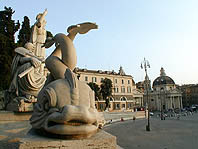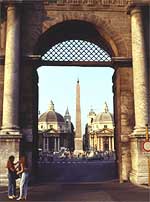Piazza del Popolo
Piazza del Popolo
 (1816 - 1820) Giuseppe Valadier, favorite architect and town planner of two Popes during Napoleon's occupation of Rome (1808-14), reshaped the square and enlarged it into a large oval, surrounding the central obelisk with four lion fountains.
(1816 - 1820) Giuseppe Valadier, favorite architect and town planner of two Popes during Napoleon's occupation of Rome (1808-14), reshaped the square and enlarged it into a large oval, surrounding the central obelisk with four lion fountains.
On one side, he created a typically French vista leading up to the Pincio Gardens, with neoclassical sphinxes on the first tier, statues of men in phrygian caps on the second and an arcaded fountain above.
The elegant open square with towering obelisk make a gracious first vision for pilgrims and tourists (in the pre-air, pre-rail era) as they came into Rome through its main entrance, the Porta Flaminia gate.
Gateway of old Porta Flaminia - now Porta del Popolo (1562). The 3C Aurelian walls are intercepted by a massive gate, built by Pope Pius IV Medici to impress pilgrims arriving from the North.
Don't miss the Medici crest: 6 large pills (!) on a shield. When Queen Christina of Sweden, having abdicated and converted to Catholicism, arrived here in 1655, Pope Alexander VII Chigi had Bernini redecorate the inner face of the gate with scrolls and garlands and the Chigi crest (2 trees and 2 Papal hills with stars).
|
Piazza del Popolo
History 220 BC. The Romans build the Via Flaminia, that goes from Rome to the Adriatic sea. 10 BC. The obelisk was brought by Emperor Augustus from Egypt to adorn the Circus Maximus. It is 3,000 years old, the largest in Rome and was moved here in 1589. 1C AD. Nero's mother Agrippina had her pyramid tomb here. Famous for dispatching unwanted enemies with poison (even her own husband Emperor Claudius), she helped corrupt her son with her wicked ways (incest is best). 15-18 C. Monastery buildings with their kitchen gardens spilled into the square. 1589. The Egyptian obelisk was moved here from the Circus Maximus. 1816 -1820. Joseph Valadier transformed the square into its glorious present form. |
Trident Art
Rome through the ages has always been a hot bed of art. Whether copying graceful Greek statues, bringing mosaics to a high art form, inventing the "Futurist" movement at the turn of this century and the Neo-classicism of De Chirico and his pals, and more recently the flowering of artists and galleries when Rome was the "dolce vita" capital.
Though in a quiescent period now, there are many bustling galleries and suppliers and artists everywhere in an .area called "Tridente", the streets that start from Piazza del Popolo: Via del Babuino, Via del Corso, Via Ripetta, and nearby roads such as Via Margutta.
St. Maria del Popolo
(1099). Tucked into part of the ancient Roman walls. The malevolent ghost of Nero, considered the Anti-Christ because of his persecutions, used to haunt the area from his nearby pyramid tomb.
At popular demand, Pope Pascal II (1099-1118) exorcised the area by chopping down a walnut tree which had grown over Nero's tomb, throwing the tomb into the river and building a church here. The exorcism is depicted in the image on the right of the chancel arches, in gilded stucco.
Another pyramid had existed on the other side of the square (near Rosati's cafe) housing Nero's mother's remains. Rebuilt (1472-77) during Sixtus IV della Rovere's papacy, this church is an excellent example of early Renaissance architecture. Baroque (17C) stucco (type of plaster) statues were added above the nave's arches by Bernini.
![]() Caravaggio's superb paintings in the Cerasi chapel (first on the left when you reach the altar). He was the master of chiaroscuro - bright light on one object and heavy shadows all around.
Caravaggio's superb paintings in the Cerasi chapel (first on the left when you reach the altar). He was the master of chiaroscuro - bright light on one object and heavy shadows all around.
One is the Conversion of St. Paul on horseback on the road to Damascus.
In the other, 3 men raise a fourth tied to a cross: the Crucifixion of St. Peter. There are often art shows in the large hall up a few stairs behind the church.
St. Maria dei Miracoli and St. Maria di Montesanto

(1679 Carlo Rainaldi with a little help from his friends Bernini and Fontana) Baroque.
These seemingly identical churches were built to impress and welcome pilgrims as the arrived in Rome through the Porta Flaminia.
The architecture is masterful: they are neither identical nor the same size! One is round, the other elliptical and they have different shaped domes.
An artist and intellectual stamping ground, many funeral services for artists are held in these churches.
Piazza del Popolo (Map G 1)